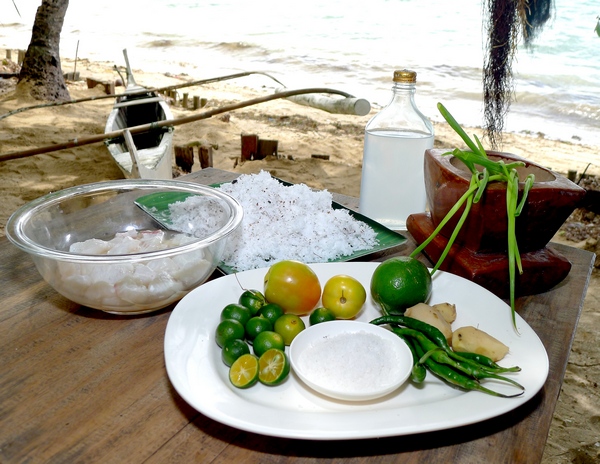
Edilberto Alegre, the poet of food writing, describes kinilaw as “a race for freshness.”
It calls for newly caught fish,one that has not gone through freezing, and wasn’t bought from the open counter (even if covered with ice) of a
supermarket seafood section.
The word must have come from “hilaw,” the Cebuano word for “raw”—as in raw or uncooked meat, hilaw nga manga or unripe mango. The prefix “ki” is added to denote that it is cooked like raw: ki + hilaw = kinilaw.
In the triumvirate of favorite Cebuano methods of cooking, kinilaw must be the oldest method.
For before man discovered the use of fire, we must have eaten most things raw.
The flesh of the fish is soft enough to be eaten straight from the sea.
I talked to a fisherman who said that he brings salt and siling kulikot when he goes out to sea.
As soon as he gets a fish, he cleans and washes it in the sea. He then sprinkles it with salt, and with a bite of the kulikot, he bites into it. That’s kinilaw in its rawest form!
Other seafood are made into kinilaw by Cebuanos. Examples:
Lato or sea grapes, as children call it, is Caulerpa lentillifera, a seaweed; Lukot, the egg ribbons of sea hares, or sea slugs; and Guso or raw agar-agar. Ba’at and Sunlutan, sea urchins, are also popular kinilaw ingredients.
It is interesting to note that these are made into kinilaw without the use of coconut cream.
In a province wrapped by towns close to the shoreline, kinilaw should be an easy dish to concoct.
I would think every town has its version of kinilaw.
Most fleshy fish can be used for kinilaw.
Tanguigue is one of them. Just cut it into bite-sized pieces. Some cooks prefer Molmol. I grew up liking Bolinaw.
The soft flesh of these tiny fish is easily cooked in vinegar. What takes time is cleaning it. One has to be quick because Bolinaw will not stay fresh for long.
First, remove the head and in one quick stroke, run your thumb through the side and when you reach the tail, immediately cut the base of the spine and pull it away from the fish. Once you have gathered a fair amount of cleaned Bolinao, wash it and drain the water.
Place in a bowl and pour vinegar over it.
Let it stand while you cut the ginger, onions and tomatoes.
The coconut cream should have been squeezed and set aside before. Mix all of the Bolinao, ginger, onions, tomatoes, salt, coconut cream– and there you have it: Kinilaw nga Bolinaw!
The process is basically the same for all fishes.
There are more versions of kinilaw: Mountain folks make kinilaw out of unripe mature Nangka.
The Nangka is cut into big pieces and boiled until tender.
It is cooled, and later, water is squeezed out and the nangka is cut into smaller pieces. vinegar is added, along with ginger, tomatoes and onions.
Salt and coconut cream are then mixed.
The heart of the banana is also made into kinilaw.
The method of cooking is the same as that of the nangka.
The banana heart is boiled until tender and when cool, it is sliced into small pieces.
We can say that kinilaw is a dish and a method of cooking.
Cebuanos do not call this dish a salad. For them this too is kinilaw.